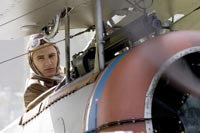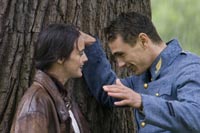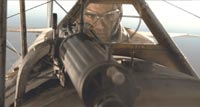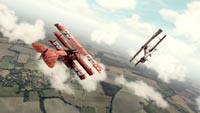In 1917, just before the U.S. entered World War I and just after the introduction of airplanes in combat, several dozen American young men volunteered to help defend France against the Germans. Their aerial unit became known as the Lafayette Escadrille. Flyboys is inspired by their true story.
In the opening scenes, we’re introduced to a handful of these men. There’s Blaine Rawlings (James Franco), who’s looking for his place in the world after the bank foreclosed on his family ranch. William Jensen (Philip Winchester) comes from a long line of military heroes, and wants to earn his spot of honor in the family tree. Briggs Lowry (Tyler Labine) is bullied into volunteering by his domineering and disappointed dad. African-American boxer Eugene Skinner (Abdul Salis), who’d moved to more diverse and accepting France years earlier, wants to pay back his adopted country. Once they arrive in the French airfield that will be their home, they’re given a stiff welcome by French Captain Thenault (Jean Reno) and a jaded warning from lone American veteran Reed Cassidy (Martin Henderson).

Though Cassidy tells them the average life expectancy for new flyboys is three to six weeks, we don’t get any hint of that danger during their training—which consists mainly of spinning in a chair and then trying to walk a straight line, shooting up bales of hay from a moving makeshift cockpit, and playing with toy planes. There’s even the helpful instruction that those white aviator scarves aren’t just fetching, they’re also functional. In the midst of all this, while learning how to fly, two of our boys crash conveniently close to the local prostitute house. While his wounds are being nursed, our leading man, Rawlings, meets the one “nice girl” in the bunch, a non-English-speaking local named Lucienne (Jennifer Decker).
Though we have all the requisite characters for any self-respecting war movie—the cowboy, the aristocrat, the underdog, the minority, the uncaring leader, the jaded veteran, the damsel in distress, the enemy, and even the Bible-thumping weirdo—this isn’t really a war movie. It’s really war lite. For example, before their first mission, Cassidy hands a couple of the men two items: a hammer and a handgun. The hammer is for when a part of the engine gives them trouble while flying—apparently banging on it helps. And the handgun is in case they go down in flames and want to cut to the chase instead of suffering a slow, agonizing death. These are grim realities of war—faulty equipment and countless fatalities—and yet somehow this scene plays out as quaint, with the squeaky-clean fliers exchanging looks of “gosh, I hope I don’t have to use these.”

In another scene, the new fliers are retreating for the night to the mansion that serves as their barracks. With aw-shucks enthusiasm, one quips, “These Frenchies sure put on a nice war.” For the most part, people who die just kind of slump over in their seat, or crumple gracefully to the French dirt. And is there really this much scowling in aerial combat? At turns the movie feels like War! the play (in precious, folksy scenes), War! the Disney ride (during nicely choreographed flight scenes), and War! the musical (when Bible boy starts singing “Onward Christian Soldiers” while flying into battle).
As the men take flight on their first mission, we’re treated to one of the film’s high points—the stunning visuals. As the planes fly over the beautiful French countryside, Lucienne—dressed in a flowing dress and wide-brimmed hat—turns her exquisite French face to the skies with a look of admiration and concern. There are several such scenes of lovely French landscapes and the planes emerging from a low-lying early morning fog. It’s as if the cinematographers are hanging portraits throughout the film.

During the first mission, we’re also treated to another of the film’s high points—the aerial shots. Much is made of the fact that this is the first World War I aviation film in over 40 years. Clearly the planes are the centerpiece. However, part of the impact of these aerial sequences is lost because we’re a little fuzzy on the point of each mission. We aren’t really invested in what they’re trying to accomplish, and as such, I often felt more like a spectator at an air show than a viewer rooting for our boys to return home victorious.
Overall it feels as though the directors and producers spent so much time on the visuals that they forgot to tie them all together with needed transitions (you can almost hear someone yelling “cut!” before the abrupt end to many battle scenes), plausible action (how does one land a plane and run across a battlefield mere feet from the enemy trench and not get shot?), realistic timeframe (apparently you can learn a foreign language in a week’s time if you’re in love), and believable dialogue (I’m no WWI buff, but I have a hard time picturing soldiers saying stuff like “Those guys sure can tie one on!”).

There’s a missed opportunity toward the end of the film when Rawlings laments the lack of justice in battle, and Cassidy advises him, “You have to find your own meaning in war.” This is a great point, but it’s never really explored with any of our characters. We see the various motivations that led the men to war, and though there’s a postscript of what happened to each of the surviving men afterward, we don’t really get a sense of what any of these men takes away from this experience.
Similarly, I’m unsure of what moviegoers are supposed to come away with either. Flyboys plays like one of the many sports-oriented “inspired by a true story” flicks that’s released in the past couple years. This folksy quaintness works well on the sports field, but on the battlefield, it seems lacking. War is much more complicated and gritty than “the big game,” and that needs to be explored. So while Flyboys has lots of heart, eye candy, and likable characters, its lack of more grit, believability, and substance stops it from truly inspiring.
Talk About It
Discussion starters- Which of the flyboys do you relate to most? Why? Could you have done what they did—even though the U.S. had not yet officially joined the war
- At one point Rawlings complains, “I thought there was supposed to be some sort of justice in the way we fight.” What do you think of this comment? Is there justice in war? Is there a way to fight fair? And if so, what is that
- Toward the end of the film, Cassidy tells Rawlings that war is never won, it just ends. Do you agree or disagree with this assessment? Why
- Do you think any of the characters found their own meaning in the war? If so, what?
The Family Corner
For parents to considerFlyboys is rated PG-13 for war action violence and some sexual content. Obviously this war movie contains violence, including planes being shot down, civilians being gunned down, and people being shot at close range. Three young children narrowly escape from enemy soldiers. And there’s a little groping and cleavage in the scene with the prostitutes.
Photos © Copyright MGM
Copyright © 2006 Christianity Today. Click for reprint information.
What Other Critics Are Saying
compiled by Jeffrey Overstreetfrom Film Forum, 09/28/06In 1917, when some young American soldiers volunteered to start their engines, take to the air, and fight German pilots in an effort to defend France, their team—the Lafayette Escadrille—blasted their way into the history books.
It’s a thrilling story, and Flyboys aims to bring it to life. But a movie just won’t fly unless it has a solid screenplay and strong performances. Flyboys falls short on both counts, and thus never gets off the ground.
Christian Hamaker (Crosswalk) writes, “Flyboys is, we’re told, ‘inspired by a true story,’ but it’s hard to see how adherence to actual facts could have made for a less interesting story. An intriguing historical premise … gives way to a by-the-numbers story … .”
David DiCerto (Catholic News Service) says it’s “a story that deserves a better telling,” and calls Flyboys “uninspired.” He calls the combat scenes “visually impressive,” but concludes that, because of weak storytelling, these sequences “lack emotional impact.”
Christopher Lyon (Plugged In) raves about the effects sequences, and adds, “It stunningly recaptures the boyhood rush of imaging oneself locked in 3-D air duels with the Red Baron or, more likely, piloting an X-Wing Tie Fighter against Darth Vader in deep space.” But he agrees with other critics about the film’s weaknesses. “When earthbound, these pilots mostly feel two-dimensional, keeping the story from ever achieving a real epic quality.”
Frederica Matthewes-Green (Frederica.com, originally published in The National Review) remarks, “War movies are the Dinty Moore Beef Stew of cinema: meat, potatoes, coupla carrots, and no surprises. … If this is the kind of movie you relish, Flyboys will hit the spot. … Perhaps there is no way to tell it that doesn’t sound familiar, because heroes everywhere have some things in common.”
Mainstream critics agree that the film’s screenplay sputters, even as its special effects soar.












